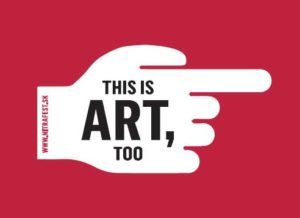 For the sixth year in a row (since 2014), the interactive project This Is Art, Too organised by Association Divadelná Nitra uses a symbol and a simple banner to mark often forgotten, neglected or nearly destroyed works of architecture, urbanism and art. The previous edition was organised newly in collaboration with the civic association Nitra Cultural Heritage. Five new sites have been added to the already highlighted 33, once again corresponding to the current year’s festival theme. Faces of Freedom serve as an opportunity to recall a number of monuments of war, liberation, as well as those documenting life in times of ‘freedom’ and the ‘defence’ of world peace.
For the sixth year in a row (since 2014), the interactive project This Is Art, Too organised by Association Divadelná Nitra uses a symbol and a simple banner to mark often forgotten, neglected or nearly destroyed works of architecture, urbanism and art. The previous edition was organised newly in collaboration with the civic association Nitra Cultural Heritage. Five new sites have been added to the already highlighted 33, once again corresponding to the current year’s festival theme. Faces of Freedom serve as an opportunity to recall a number of monuments of war, liberation, as well as those documenting life in times of ‘freedom’ and the ‘defence’ of world peace.
- The World War I Military Cemetery in Nitra was started in 1915 besides the Military Hospital in Mlynárce. In 1924, a monument with a statue of a soldier, created by Nitra‑resident sculptor Július Bártfay, was erected in the middle of the grounds. It depicts a soldier standing above the graves of his comrades and the civilian victims of the world war.
- The Red Army Monument was uncovered in 1960 on the square in front of the Regional National Committee Palace (currently the District Office in Nitra). The sculpture of a Red Army Man assuming a victorious liberators’ pose was created in the spirit of Socialist realism by Tibor Bártfay, a native of Nitra. Shortly earlier, he had collaborated on the decoration of the Slavín Monument in Bratislava, which had a notable influence on the artwork in Nitra.
- The Predmostie Apartment Building was designed in 1954 − 155 by a collective of architects consisting of Michal Maximilián Scheer, Tibor Gebauer and Štefan Sojka. It is one of the largest works of post‑war urban development in Slovakia. Although the architects were still limited by certain design principles adopted form the Stalinist Soviet Union, it may be regarded as a first‑rate work of architecture with a unique urban plan. Its construction took until 1961.
- The multi‑figural sculpture A Protest Against War, installed in the City Park below Nitra Castle, was created in 1963 − 1964 by sculptor Tibor Bártfay in collaboration with architect Štefan Svetko. As the title suggests, this work warns of the threats of future war. It can therefore be considered a pacifist artwork. The collaboration between a sculptor and an architect likely also resulted in the unusual arrangement into two compositional units – a group of playing children and a self‑standing figure of a mother in the foreground, ready to protect them.
- An artwork by sculptor Ladislav Gajdoš placed at the centre of the Párovce II Residential Area, built in 1961 − 1968. The group of six concrete blocks, arranged in a line, serves a purely aesthetic function. It incorporates a repeating basic form with minimal alterations of proportion and features variations on an abstract relief on the blocks’ front side. Like many other artworks placed in the public space, it represents the collective effort to create a cultivated environment for life in Socialist society.
